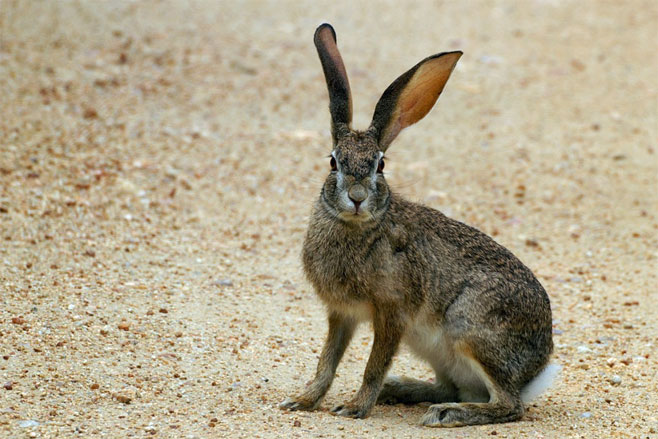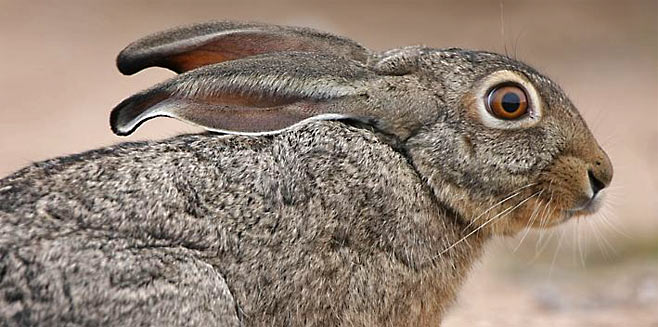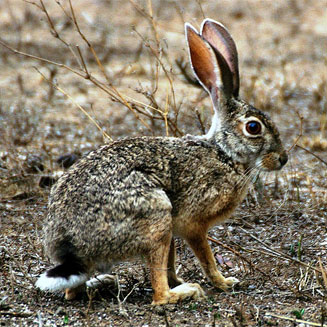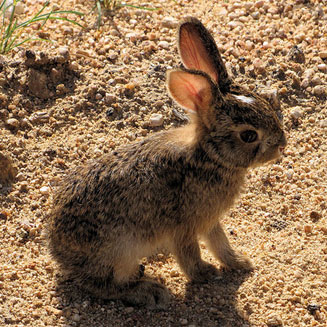|
Lepus saxatilis (Scrub hare)
kolhaas [Afrikaans]; umvundla [isiNdebele] [isiXhosa];
unogwaja [isiZulu];
mofuli [Sesotho]; moduô1ô, modiôlô [Setswana];
tsuro [Shona]; logwatja [siSwati];
mpfundla [Xitsonga]; muvhuda, khomu [Tshivenda]; shakame [Lozi]; unshuru [Yei]
!Ôas [Nama] [Damara]
Life
>
Eukaryotes >
Opisthokonta >
Metazoa (animals) > Bilateria > Deuterostomia >
Chordata > Craniata > Vertebrata (vertebrates) >
Gnathostomata (jawed vertebrates) > Teleostomi (teleost
fish) > Osteichthyes (bony fish) > Class:
Sarcopterygii (lobe-finned fish) > Stegocephalia
(terrestrial vertebrates) > Reptiliomorpha > Amniota >
Synapsida (mammal-like reptiles) > Therapsida > Theriodontia
> Cynodontia > Mammalia (mammals)
> Placentalia (placental mammals) >
Euarchontaglires > Glires > Lagomorpha (rabbits, hares and
pikas) > Family: Leporidae (rabbits, hares)
 |
|
Lepus saxatilis (Scrub hare), Kruger
National Park, South Africa. [photo Arno Meintjes
©] |
 |
|
Lepus saxatilis (Scrub hare), Velddrif,
Western Cape. [photo Trevor
Hardaker ©] |
 |
 |
|
Lepus saxatilis (Scrub hare), South Africa.
[photo Arno Meintjes
©] |
Baby Scrub hare. [photo
Dave Scott
©] |
Identification
Scrub hares have a typical hare-like body shape
with long ears, long well-developed hind legs and a short fluffy
tail. The body hair is fine and soft, the upperparts are a
brown-grey to grey colour with a black-fleck giving the coat a
grizzled appearance. The underparts are white. The head is a lighter
whitish or buff on the sides of the face and around the eyes. Most
animals have a distinct white patch on the forehead just above the
eyes. The nucal patch, situated in the nape of the neck behind the
ears is a more reddish brown than the rest of the body. The tail is
black above and white underneath. The females are larger and heavier
than the males.
Size
Size: Body length 45-65 cm; weight range 1.5
–4.5 kg.
Dental formula
 C C P P M M =
28 =
28
Distribution and habitat
Found throughout southern Africa, excluding the Namib Desert.
It generally prefers woodland and scrub cover with grass.
General behaviour
Scrub hares are nocturnal but may be active
during the early morning and the late afternoon. They occur singly
unless a female is accompanied by courting males or her offspring.
During the day they lie up in “forms” (shallow depressions in the
ground or grass), usually concealed under bushes amongst some grass.
The drab colour of the body provides good camouflage and they fold
their ears flat back against their body with the head tucked in
against the body. Characteristically of hares when threatened they
remain motionless until the last second and then suddenly break
cover and rely on their speed to escape. If caught they emit a loud
squealing sound, and will kick viciously with their large back feet
and bite if given the opportunity.
Food
The diet of scrub hares consists of the leaves,
rhizomes and stems of dry grass, but they have a preference for
green grass.
Predator, parasites and commensals
They have many natural predators including
birds of prey,
caracal,
jackal, and people.
Reproduction
Gestation is about 42 days. Females have 1-3
“leverets” per litter and may have as many as 4 litters per year. A
litter of 1 – 3 “leverets” are born after a gestation period of 42
days. At birth the leverets eyes are open, they are fully haired and
can move around soon after birth. The birth of young at an advanced
state of development is another characteristic that separates hares
from rabbits, that produce naked, blind babies in a burrow.
Conservation
Although the scrub hare numbers may be low in
certain areas due to hunting pressures and loss of habitat to
farming and urban development, they are not regarded as threatened
and their conservation status is graded as lower risk.
Text by Denise Hamerton |
